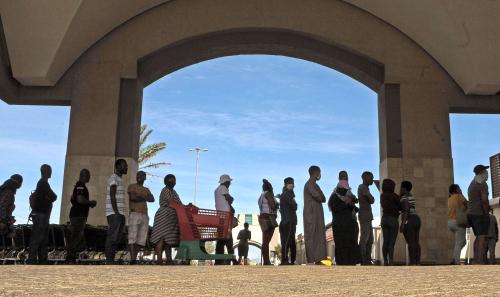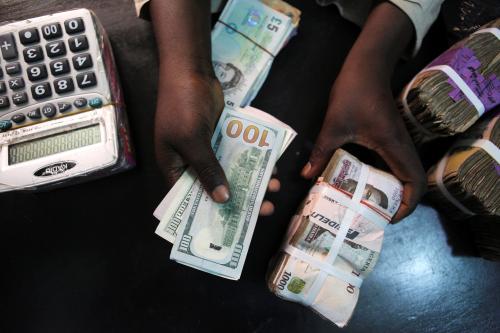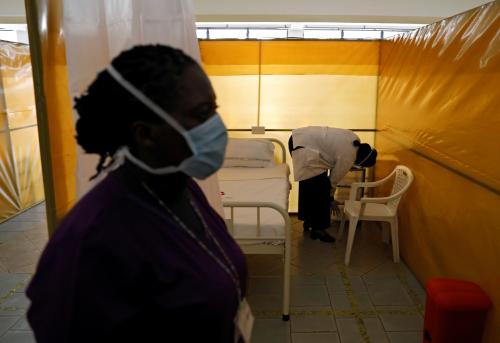African countries, like others around the world, are contending with an unprecedented shock, which merits substantial and unconditional financial assistance in the spirit of Draghi’s “whatever it takes.” The region is already facing an unprecedented synchronized and deep crisis. At all levels—health, economic, social—institutions are already overstretched. Africa was almost at a sudden stop economically even before the full brunt of COVID-19 reaches its shores. Economic performance for this year is projected to be the worst in 30 years. The health crisis is morphing into full-blown economic, financial, and food crises. These can be mitigated, but only if we act immediately and collectively, and with the full force of all resources that can be mobilized to get ahead of the pandemic. Policymakers in advanced economies have, appropriately, thrown out policy orthodoxy, and the same approach should be taken for the African countries. The outcome of the G-20’s Finance Ministers and Central Bank Governors meeting is an important first step that must be urgently complemented, scaled up, and broadened.
Following up on instructions of the G-20 leaders, on April 15, the G-20 Finance Ministers and Central Bank Governors (G-20 FMCBG) announced an action plan to bolster countries’ resources to respond appropriately to the COVID-19 pandemic. Among the key recommendations, the communique calls for: (1) swift implementation of the $200 billion emergency response packages adopted by the multilateral development banks, (2) more contributions to replenish the Poverty Reduction and Growth Trust (PRGT) and the Catastrophe Containment Relief Trust (CCRT), and, very importantly, (3) time-bound suspension of debt service payments for the poorest countries that request forbearance. The announced action plan is broadly consistent with our previous call, but it does not go far enough.
The swift implementation of the support from the multilateral development banks and the replenishment of the Trust Funds at the International Monetary Fund will provide some much-needed relief. However, the share of these resources going to African countries falls significantly short of the $200 billion needed, as estimated by the African Union, and the debt standstill does not go far enough in its scope. To truly empower African countries to effectively fight the virus and shore up the economies, we recommend the following next steps:
Expand the eligibility for the debt standstill
Countries classified as IBRD (International Bank for Reconstruction and Development) with a presumed ability to access market financing are excluded from the debt standstill. For Africa, this group of countries includes Algeria, Angola, Egypt, Libya, Morocco, South Africa, and Tunisia. Given the unique nature of the COVID-19 shock, the overriding criteria for eligibility for debt relief should be the need to effectively combat the pandemic and prepare for durable economic fallout. Under this provision, four of the top-five COVID-affected countries—Algeria, Egypt, Morocco, and South Africa—are excluded from much-needed relief. The fragile conditions in civil war-ridden and oil-dependent Libya or the recent history of Tunisia as the epicenter of the Arab Spring upheaval point to further risks that merit consideration. If the pandemic is not eradicated in these countries, success in any of their neighbors will be short-lived given their interconnectedness.
Similarly, the economic and financial spillover from distressed IBRD countries to the rest of Africa would be significant. These countries account for over 50 percent of Africa’s gross domestic product, and 46 percent and 55 percent of intra-regional exports and imports, respectively. The consequences will also reverberate beyond Africa, given these countries account for a large share of Africa’s imports from the rest of world—making up, for example, 72 percent of Africa’s imports from the European Union—and are an important source of migration to Europe. Indeed, migration challenges could rise multifold if the economies of the excluded countries collapse, further reducing job prospects for the burgeoning youth population.
Set up a process to ensure increased private creditors participation
The G-20 FMCBG’s call for the private sector to join the debt relief, while welcome, must be bolstered by tasking the IMF to work with the Institute for International Finance (IIF) and the African Union to develop solutions guaranteeing debt sustainability and continued access to capital markets in the future. Private sector debt is not only a higher share of African external debt, but it makes up a disproportionate share of the debt-servicing cost. For several African countries, even where debt levels remain relatively low, the interest cost now accounts for 20 percent or more of government revenues. Without significant private sector participation, the standstill will fall short of its objectives. Country participation in a standstill on the private debt should be voluntary. We believe it is in the long-term interest of countries classified as IBRD to participate, so there should be significant incentives in place to encourage their participation, using various levers described below.
Leverage Special Drawing Rights
To adequately confront this funding crisis, we must be bold and innovative. We believe a special purpose vehicle could be created to serve as a bridge finance facility to be accessed on a voluntary basis. If adequately structured, participating countries would benefit from a lowering of their cost of debt while keeping their hard‑earned market access, and investors would hold paper that would be much more liquid and with enhanced credit. The multilateral institutions working with the IIF and Africa should be tasked to explore this option as they develop workouts for the bilateral debt.
Strengthen governance around the utilization of mobilized resources
With the benefit of immediate and substantial relief, African governments can now better focus on vulnerable populations and bolster safety nets, and—like elsewhere in the world—support the private sector, especially SMEs, including paying arrears and ensuring minimal disruption to the flow of credit—thus avoiding deeper and more prolonged banking and economic crises. In return, African countries must pledge to build and strengthen accountability and transparency, as well as enhance predictability. Beyond enlisting the support of renowned civil society organizations working in the field of transparency, African countries should also engage their technology hubs to help build an information database to track, monitor, and evaluate the use of these funds. Effective and balanced partnerships with these NGOs and tech platforms can ensure resources reach those most in need expeditiously.
This is not a moment for incrementalism or hesitation in policy response. Strong and decisive action now will help avoid widespread sovereign defaults, contagion, and chaos in the sovereign debt markets. It will also help preserve millions of jobs on the continent, avoid widespread political and social unrest, and prevent insecurity and mass migration.











Commentary
COVID-19 and debt standstill for Africa: The G-20’s action is an important first step that must be complemented, scaled up, and broadened
April 18, 2020